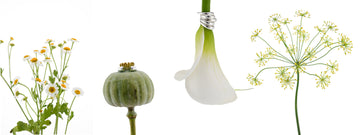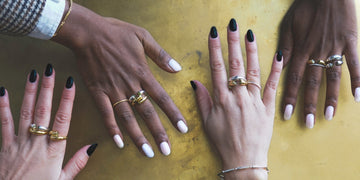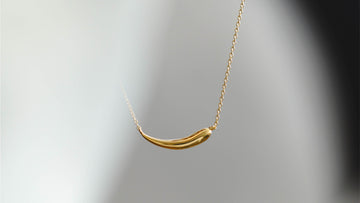Was ist ethischer Schmuck und warum ist er wichtig?
Der Aufstieg des ethischen Schmucks: Warum bewusstes Einkaufen keine Nische mehr ist
In einer Zeit, in der Fast Fashion und Massenproduktion dominieren, findet eine stille Revolution statt. Immer mehr Verbraucher fragen sich , woher ihre Produkte kommen, wer sie hergestellt hat und wie sie hergestellt wurden – insbesondere bei edlem Schmuck. Das wachsende Interesse an ethischem Schmuck ist nicht nur ein Trend; es spiegelt einen breiteren kulturellen Wandel hin zu bewusstem Konsum wider.
Transparenz, Nachhaltigkeit und Verantwortung legen zunehmend Wert auf Schmuck. Schmuck wird daher nicht mehr nur nach seinem Glanz beurteilt, sondern auch nach der Geschichte, die hinter jedem Stück steckt. In diesem Leitfaden erfahren Sie, was ethischer Schmuck ist , warum er wichtig ist und wie Sie fundierte Entscheidungen treffen können, die Ihre Werte widerspiegeln.
Was ist ethischer Schmuck?
Im Kern bezieht sich ethischer Schmuck auf Schmuck, der ohne Ausbeutung von Mensch und Umwelt hergestellt wird. Dies bedeutet, faire Arbeitspraktiken sicherzustellen, verantwortungsvolle Beschaffungsmethoden anzuwenden und die Umweltbelastung während des gesamten Produktionsprozesses zu minimieren.
Ethischer Schmuck berücksichtigt die gesamte Lieferkette – Vom Abbau der Metalle und Edelsteine über die Arbeitsbedingungen der Kunsthandwerker bis hin zu den verwendeten Verpackungsmaterialien. Es geht darum, schöne Objekte ohne hässliche Hintergrundgeschichten zu schaffen.
Dazu gehören auch Respekt für kulturelles Handwerk, Transparenz in der Geschäftstätigkeit und das Engagement für langfristige Nachhaltigkeit. Ob recyceltes Silber, konfliktfreie Diamanten oder lokal handgefertigte Designs – ethischer Schmuck versucht, die Standards einer historisch undurchsichtigen Branche neu zu definieren.
Warum ethischer Schmuck wichtig ist
Die Schmuckindustrie wird seit langem mit undurchsichtigen Lieferketten, Kinderarbeit, unsicheren Arbeitsbedingungen und Umweltzerstörung in Verbindung gebracht. Durch die Wahl von nachhaltigem und ethischem Schmuck können Verbraucher diese schädlichen Praktiken aktiv bekämpfen.
Wenn Sie in ethischen Schmuck investieren, kaufen Sie nicht nur ein Produkt – Sie unterstützen:
- Faire Löhne und sichere Bedingungen für Handwerker und Bergleute
- Umweltverträgliche Gewinnung und Produktion
- Kleingewerbe und lokale Handwerkskunst statt Massenproduktion
- Mehr Transparenz bei Beschaffung und Geschäftsbetrieb
Für viele ist das Tragen von Schmuck eine sehr persönliche Angelegenheit. Ethischer Schmuck stellt sicher, dass die Schönheit des Schmuckstücks mit der Integrität seiner Entstehung einhergeht.
Schlüsselkomponenten von ethischem Schmuck
a) Verantwortungsvolle Materialbeschaffung
Dazu gehören recycelte Metalle, Fair-Trade-zertifiziertes Gold, konfliktfreie Diamanten und im Labor gezüchtete Edelsteine. Verantwortungsvolle Beschaffung vermeidet die Unterstützung ausbeuterischer Bergbaupraktiken und reduziert die Umweltbelastung.
b) Faire Arbeitspraktiken
Ethische Schmuckmarken stellen sicher, dass alle am Prozess Beteiligten (wie Bergleute, Metallarbeiter, Steinschneider, Polierer und Designer) fair behandelt und gerecht bezahlt werden und unter sicheren Bedingungen arbeiten.
c) Nachhaltige Produktion
Dies bedeutet, Abfall, Energieverbrauch und schädliche Chemikalien während der Produktion zu minimieren. Viele ethische Juweliere verwenden umweltschonende Techniken oder arbeiten mit Lieferanten zusammen, die dies tun.
d) Transparenz und Rückverfolgbarkeit
Marken, die sich ethischen Grundsätzen verpflichtet fühlen, sind transparent und geben an, woher ihre Materialien stammen, wer ihren Schmuck hergestellt hat und wie er produziert wurde. Rückverfolgbarkeit schafft Vertrauen bei bewussten Verbrauchern.
e) Umweltfreundliche Verpackung
Nachhaltiger Schmuck wird oft mit minimaler, recycelbarer oder wiederverwendbarer Verpackung geliefert, wodurch Plastik und unnötiger Abfall vermieden werden.
f) Unterstützung des lokalen und handwerklichen Kunsthandwerks
Anstatt im Ausland in Massen zu produzieren, entscheiden sich viele ethische Marken für eine enge Zusammenarbeit mit erfahrenen Kunsthandwerkern, um traditionelle Techniken zu bewahren und die Qualität sicherzustellen.
So erkennen Sie ethische Schmuckmarken
Nicht alle Marken, die behaupten , ethisch zu handeln, sind es auch tatsächlich. Hier ist, worauf Sie achten sollten:
- Klare Herkunftsinformationen zu Metallen und Edelsteinen
- Zertifizierungen wie Fairmined, Fairtrade Gold oder SCS Global Services
- Transparente Lieferkettenbeschreibungen auf ihrer Website
- Recycelte oder Upcycling-Materialien sind deutlich gekennzeichnet
- Direkte Beziehungen zu Handwerkern oder lokalen Werkstätten
- Verpflichtungserklärungen oder Nachhaltigkeitsberichte
- Überprüfung oder Bewertungen durch Dritte
Vertrauen Sie Ihrem Instinkt: Wenn eine Marke vage oder ausweichend über ihre Praktiken ist, ist sie wahrscheinlich nicht so ethisch, wie sie behauptet.
Ethischer vs. nachhaltiger Schmuck: Was ist der Unterschied?
Obwohl die Begriffe oft synonym verwendet werden, sind sie nicht identisch.
- Bei ethischem Schmuck steht der menschliche Aspekt im Mittelpunkt: faire Arbeitsbedingungen, Transparenz und sichere Arbeitsbedingungen.
- Nachhaltiger Schmuck betont die Umweltauswirkungen : geringer CO2-Fußabdruck, umweltfreundliche Materialien und Abfallreduzierung.
Die bewusstesten Marken streben beides an. Bei Attona beispielsweise wird unser Schmuck in kleinen Mengen aus recycelten Edelmetallen handgefertigt, wobei bei jedem Schritt ethische Beschaffung mit Nachhaltigkeit kombiniert wird.
Die Komplexität und Herausforderungen von ethischem Schmuck
Ethischer Schmuck ist nicht immer schwarz und weiß. Selbst die verantwortungsvollsten Marken stehen vor echten Herausforderungen, darunter:
- Transparenz bei der Beschaffung: Es ist nicht immer möglich, Materialien bis zu ihrem Ursprung zurückzuverfolgen.
- Kosten: Ethische Produktion ist teurer, was die Stücke für manche Kunden weniger erschwinglich machen kann.
- Greenwashing: Manche Unternehmen vermarkten sich als „ethisch“, ohne dies zu belegen, und täuschen so gutmeinende Käufer.
- Begrenztes Angebot: Zertifizierte Fair-Trade- oder Recyclingmaterialien sind nicht in unbegrenzten Mengen verfügbar.
Dennoch ist Fortschritt wichtiger als Perfektion. Bessere Entscheidungen zu treffen, auch wenn sie nicht perfekt sind, ist ein großer Schritt nach vorne.
Attonas Engagement für ethischen Schmuck
Wir bei Attona glauben, dass sich Schmuck genauso gut anfühlen sollte, wie er aussieht. Deshalb haben wir unsere Marke auf bewussten Werten und Handwerkskunst aufgebaut.
- Wir verwenden recyceltes Sterlingsilber und Goldplattierung, um die Umweltbelastung zu reduzieren.
- Unsere Stücke werden in Zürich entworfen und in Zusammenarbeit mit Kunsthandwerkern handgefertigt, die fair bezahlt werden und unter sicheren, würdigen Bedingungen arbeiten.
- Wir halten die Produktion klein und zielgerichtet und vermeiden Abfall und Überbestände.
- Jedes Stück ist auf Langlebigkeit ausgelegt: zeitlos im Design und bedeutungsvoll in seiner Geschichte.
Wir verkaufen nicht einfach nur Schmuck. Wir erzählen Geschichten durch Design und würdigen die Menschen und Prozesse hinter jedem Stück.
Erfahren Sie mehr über Attona
Sehen Sie sich unsere ethisch einwandfreie Schmuckkollektion an
Abschließende Gedanken: Kleine Entscheidungen, große Wirkung
Schmuck ist oft ein Symbol der Liebe, des Festes oder der Erinnerung. Sorgfältig ausgewählt, kann er auch ein Symbol Ihrer Werte sein. Mit der Wahl von ethischem Schmuck tragen Sie zu einer transparenteren, verantwortungsvolleren und schöneren Zukunft der Branche bei.
Jedes Stück, das Sie tragen, erzählt eine Geschichte. Machen Sie es zu einer, auf die Sie stolz sind.




